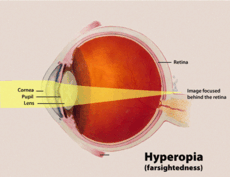- Visual impairment
-
Visual impairment Classification and external resources 
ICD-10 H54 ICD-9 369 Visual impairment (or vision impairment) is vision loss (of a person) to such a degree as to qualify as an additional support need through a significant limitation of visual capability resulting from either disease, trauma, or congenital or degenerative conditions that cannot be corrected by conventional means, such as refractive correction, medication, or surgery.[1][2][3] This functional loss of vision is typically defined to manifest with
- best corrected visual acuity of less than 20/60, or significant central field defect,
- significant peripheral field defect including homonymous or heteronymous bilateral visual, field defect or generalized contraction or constriction of field, or
- reduced peak contrast sensitivity with either of the above conditions.[1][2][3][4]
In the United States, the terms "partially sighted", "low vision", "legally blind" and "totally blind" are used by schools, colleges, and other educational institutions to describe students with visual impairments.[5] They are defined as follows:
- Partially sighted indicates some type of visual problem, with a need of person to receive special education in some cases;
- Low vision generally refers to a severe visual impairment, not necessarily limited to distance vision. Low vision applies to all individuals with sight who are unable to read the newspaper at a normal viewing distance, even with the aid of eyeglasses or contact lenses. They use a combination of vision and other senses to learn, although they may require adaptations in lighting or the size of print, and, sometimes, Braille;
- Legally blind indicates that a person has less than 20/200 vision in the better eye after best correction (contact lenses or glasses), or a field of vision of less than 20 degrees in the better eye; and
- Totally blind students learn via Braille or other non-visual media.
Visual impairment is the consequence of a functional loss of vision, rather than the eye disorder itself. Eye disorders which can lead to visual impairments can include retinal degeneration, albinism, cataracts, glaucoma, muscular problems that result in visual disturbances, corneal disorders, diabetic retinopathy, congenital disorders, and infection." Visual impairment can also be caused by brain and nerve disorders, in which case it is usually termed cortical visual impairment (CVI).
The American Medical Association's Guides to the Evaluation of Permanent Impairment attempts to provide "a standardized, objective approach to evaluating medical impairments." The Visual System chapter "provides criteria for evaluating permanent impairment of the visual system as it affects an individual's ability to perform activities of daily living."[6] The Guide has estimated that the loss of one eye equals 25% impairment of the visual system and 24% impairment of the whole person;[6][7] total loss of vision in both eyes is considered to be 100% visual impairment and 85% impairment of the whole person.[6]
Visual impairments have considerable economic impact on even developed countries.[8] 'A major proportion of global visual impairment is preventable'.[9]
See also
- Accessible image
- Maguire v SOCOG 2000 (Australian legal case about making a website accessible to a visually impaired person)
- GPS for the visually impaired
- Touch user interface
- Center for the Partially Sighted
References
- ^ a b Arditi, A., & Rosenthal, B. (1998). "Developing an objective definition of visual impairment." In Vision '96: Proceedings of the International Low Vision Conference (pp. 331-334). Madrid, Spain: ONCE.
- ^ a b Medicare Vision Rehabilitation Services Act of 2003 HR 1902 IH
- ^ a b larrybelote.com
- ^ medem.com
- ^ National Dissemination Center for Children with Disabilities
- ^ a b c AMA Guides
- ^ Eye Trauma Epidemiology and Prevention
- ^ Taylor, HR; Pezzullo, ML; Keeffe, JE (2006). "The economic impact and cost of visual impairment in Australia". British journal of ophthalmology 90 (3): 272–5. doi:10.1136/bjo.2005.080986. PMC 1856946. PMID 16488942. http://www.pubmedcentral.nih.gov/articlerender.fcgi?tool=pmcentrez&artid=1856946.
- ^ Agarwal, R (1997), Prevention of visual impairment, British Journal of Optometry and Dispensing, 5(2), page 48.
External links
- http://www.direct.gov.uk/disability Directgov disabled people - UK govt information
- CDC’s National Center on Birth Defects and Developmental Disabilities
- World Health Organization site on blindness and visual impairment
- Eye Conditions (RNIB)
- Center for the Partially Sighted Low Vision Information and Resources
Categories:- Disability
- Diseases of the eye and adnexa
Wikimedia Foundation. 2010.
